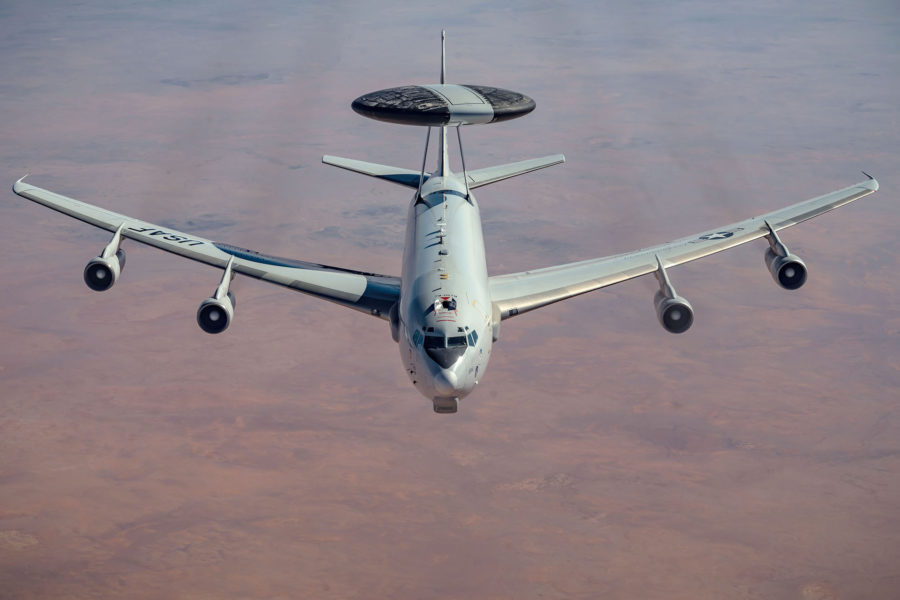The E-3 Airborne Warning and Control System (AWACS) is a heavily modified Boeing 707-320B tasked with all-weather, air and maritime surveillance, command and control, battle management, target, threat, and emitter detection, classification, and tracking.
The aircraft is capable of surveilling airspace in excess of a 250-mile radius from surface to stratosphere. AWACS coordinates theater air operations in direct subordination to joint/combined air and space operations centers. It can simultaneously conduct C2, BM, and target detection/tracking. E-3Bs were upgraded to Block 30/35 standards in 2001 and current Block 40/45 aircraft are redesignated E-3G.

Block 40/45 was the most comprehensive enhancement to date and improved tracking/identification, system reliability, and life-cycle cost. Mods included open-architecture computing, operator workload reduction, new consoles, improved electronic support measures (ESM), and passive surveillance capability. DRAGON (Diminishing manufacturing sources Replacement of Avionics for Global Operations and Navigation) upgrades added a digital cockpit and next-generation CNS/GATM. The E-3 is increasingly unable to counter current and emerging threats and suffers less than a 60 percent mission capable rate due to obsolescence.
USAF sharply curtailed E-3 modernization and retired roughly half the fleet, opting instead to award a $1.2 billion contract to adapt the Boeing E-7A Wedgetail operated by several allies to meet USAF requirements. The service plans to buy 26 E-7As with two “production representative” prototypes already on order to begin testing, which has already slipped a year to 2028.
Future E-3 upgrades will be limited to sensors, comms, networking, and computing improvements to maintain capability until retirement. Upgrades are focused on the AWACS Communications Integration Program (ACIP ) which will include BLOS SATCOM/second-generation NATO UHF, and anti-jam GPS. USAF began retiring E-3s in FY23, reducing the fleet to 16 aircraft to improve sustainment through phaseout targeted for FY29.
E-3 Sentry Technical Data
Contractors: Boeing, Northrop Grumman (radar); Lockheed Martin (computer); Rockwell Collins (DRAGON cockpit upgrade).
First Flight: Oct. 31, 1975 (full avionics).
Delivered: March 1977-1984.
IOC: 1977; July 28, 2014 (Block 40/45).
Production: 31.
Inventory: Eight (E-3B); 23 (E-3G).
Operator: ACC, PACAF, AFRC (associate).
Aircraft Location: JB Elmendorf-Richardson, Alaska; Kadena AB, Japan; Tinker AFB, Okla.
Active Variants: •E-3B. Block 30/35 upgraded aircraft. •E-3C. Block 30/35 upgraded aircraft with additional advanced capabilities. •E-3G. Block 40/45 upgraded aircraft.
Dimensions: Span 145.8 ft, length 152.9 ft, height 41.8 ft.
Weight: Max T-O 335,000 lb.
Power Plant: Four Pratt & Whitney TF33-PW-100A turbofans, each 21,000 lb thrust.
Performance: Speed 360 mph, range 5,000+ miles (air refuelable).
Ceiling: Above 35,000 ft.
Accommodation: Two pilots, navigator, flight engineer, 13-19 mission specialists.


